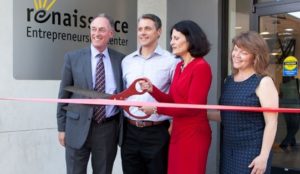Lessons in Going to Scale is a newly-launched blog series featuring on-the-ground stories from nonprofit organizations at different points in their scaling trajectory. Hear from S&I 100 CEOs and nonprofit leaders in health, education, youth, and poverty alleviation about the strategies and challenges of developing a scaling model.

How S&I 100 organization Renaissance Entrepreneurship Center used existing resources and infrastructure to scale geographically and open a fourth site in the Bay Area. CEO Sharon Miller shares what she learned during the process.
Kasey Arnold was a talented writer and an accomplished corporate marketer who was feeling stuck and unable to generate enough business from her one-person operation. Recently, she was down on her luck as an entrepreneur, barely making enough money to get by and living out of her car. She heard about Renaissance Entrepreneurship Center’s (Renaissance) small business training and support services in her community, and intrigued by the possibility of boosting her bottom line, she signed up for Urban FIRE entrepreneurship class at our newest center in Marin. Through the training she received at Renaissance Marin, Kasey was able to transform herself from a contractor-for-hire to an independent business with a niche market. She was able to hone her marketing message and narrow her focus and her clients. As a result, Kasey was able to secure new clients who truly appreciated her expertise. Recently, she was offered shares as well as a significant hourly rate by a new startup. She now has more work than she can handle and was able to take a vacation for the first time in years.
Opening a fourth center has allowed us to scale access to business training, resources, and other support services for many more local entrepreneurs like Kasey living in under-resourced communities in the San Francisco Bay Area. Founded in 1985, Renaissance has grown from offering services through one center in San Francisco to four centers and multiple off-site locations throughout the Bay Area. As demand for our services grew over the years, we began looking for opportunities to provide small business training and support services in nearby communities that didn’t have access to entrepreneurial resources.
The decision to open a fourth center in Marin County in 2012 was one that took careful planning. While recognizing the existing demand, we first had to ask ourselves if opening a new center was the best way to scale our services. One of the most important questions we had to answer was: Could we extend our services and reach new populations with existing resources and infrastructure?
After taking a year to review Renaissance’s financial and operational systems and mapping out opportunities for cost-effective program growth, the answer we came to was ‘yes.’ Here are two strategies that were essential to developing a successful scaling model for opening a new site:
1. Centralized Headquarters. Each Renaissance center offers a unique set of services catered to the needs of local aspiring and established entrepreneurs. We manage finance, operations, HR and provide administrative support from our headquarters in San Francisco to allow our program staff to fully engage in program development and community outreach. Our individual center teams have the creative freedom to design programs and pursue opportunities to meet the needs/market demands specific to the communities in which they operate, without the burden of financial management or administrative processes. For example, one of our centers provides fully bilingual services, others host networking events, and another houses a large business incubator.
2. Connecting Teams & Resources. Promoting leadership within the team is something we found to be an essential ingredient for scale. We engage Renaissance staff in cross-division and cross-site projects, pulling the best talent and skills for certain initiatives. In addition to saving money by using in-house expertise and human resources, these projects give our staff an opportunity to work together, learn, support, and inspire each other in carrying out the organization’s mission. Our monthly in-person team meetings keep the staff connected and aware of each other’s work – a not-so-obvious, yet equally important factor in overall scaling strategy.
We have successfully employed both practices to become a four-site organization last year. While we partnered with the Marin Community Foundation to open the center and hired new staff to run the center, we continue to provide operational and administrative support from the headquarters.
While scaling strategies are definitely unique to different types of nonprofit organizations — and a lot depends on the environment and circumstances in which they operate – the main lesson we learned in this process is not just to look for opportunities to scale, but to take the time to map out what the model will look like structurally at your organization. We continue to stay alert to opportunities for offering small business training and support services in nearby communities. After successfully opening the Marin Center, we believe that scaling is a necessary, not an optional, component in our growth strategy.
Would you like to connect with Renaissance’s CEO Sharon Miller? Contact her at 415.348.6243 or Sharon@rencenter.org
To learn more about Renaissance and their scaling plans, visit their S&I 100 profile.